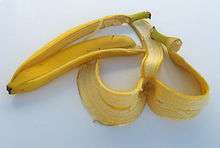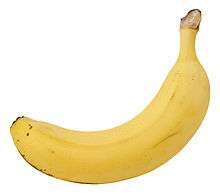Banana peel
A banana peel, called banana skin in British English, is the outer covering of the banana fruit. Banana peels are used as food for animals, in water purification, for manufacturing of several biochemical products as well as for jokes and comical situations.

.jpg)

There are several methods to remove a peel from a banana.
Use
Bananas are a popular fruit consumed worldwide with a yearly production of over 165 million tonnes in 2011. Once the peel is removed, the fruit can be eaten raw or cooked and the peel is generally discarded. Because of this removal of the banana peel, a significant amount of organic waste is generated.[1][2]
Banana peels are sometimes used as feedstock for cattle, goats, pigs, monkeys, poultry, rabbits, fish, zebras and several other species, typically on small farms in regions where bananas are grown.[3] There are some concerns over the impact of tannins contained in the peels on animals that consume them.[4][5]
The nutritional value of banana peel depends on the stage of maturity and the cultivar; for example plantain peels contain less fibre than dessert banana peels, and lignin content increases with ripening (from 7 to 15% dry matter). On average, banana peels contain 6-9% dry matter of protein and 20-30% fibre (measured as NDF). Green plantain peels contain 40% starch that is transformed into sugars after ripening. Green banana peels contain much less starch (about 15%) when green than plantain peels, while ripe banana peels contain up to 30% free sugars.[4]
Banana peels are also used for water purification,[6] to produce ethanol,[7] cellulase,[8] laccase,[9] as fertilizer[10] and in composting.[11]
In comical context
Banana peel is also part of the classic physical comedy slapstick visual gag, the "slipping on a banana peel".[12][13] This gag was already seen as classic in 1920s America.[14] It can be traced to the late 19th century, when banana peel waste was considered a public hazard in a number of American towns.[15][16] Although banana peel-slipping jokes date to at least 1854, they became much more popular, beginning in the late-1860s, when the large-scale importation of bananas made them more readily available.[17] Vaudeville comedian Cal Stewart included banana peel jokes in one of the earliest comedy albums, Uncle Josh in a Department Store in 1903.[18] Before banana peel jokes came into vogue, orange peels, and sometimes peach skins, or fruit peels/peelings/or skins, generally, were funny, as well as dangerous.[17] Slipping on a banana peel was at one point a real concern with municipal ordinances governing the disposal of the peel.[19][20]
The coefficient of friction of banana peel on a linoleum surface was measured at just 0.07, about half that of lubricated metal on metal. Researchers attribute this to the crushing of the natural polysaccharide follicular gel, releasing a homogenous sol.[21] This unsurprising finding was awarded the 2014 Ig Nobel Prize for physics.[22]
Peeling methods

Most people peel a banana by cutting or snapping the stem and divide the peel into sections while pulling them away from the bared fruit. Another way of peeling a banana is done in the opposite direction, from the end with the brownish floral residue—a way usually perceived as "upside down". This way is also known as the "monkey method", since it is how monkeys are said to peel bananas.[23]
When the tip of a banana is pinched with two fingers, it will split and the peel comes off in two clean sections. The inner fibres, or "strings", between the fruit and the peel will remain attached to the peel and the stem of the banana can be used as a handle when eating the banana.
Psychoactive effects of banana peels
There has been a widespread belief that banana peels contain a psychoactive substance, and that smoking them may produce a "high", or a sense of relaxation. This belief, which may be a rumor or urban legend, is often associated with the 1966 song "Mellow Yellow" by Donovan. A recipe for the extraction of the fictional chemical bananadine is found in The Anarchist Cookbook of 1971.
References
- Derived from: "FAOSTAT". Food and Agriculture Organization of the United Nations. The data for bananas and plantains for 2011 were combined as the two are distinguished by some countries but combined under "bananas" by others.
- G.M. Babatunde: Availability of banana and plantain products for animal feeding. In: D. Machin, S. Nyvold: Roots, tubers, plantains and bananas in animal feeding. Proceedings of the FAO Expert Consultation held in CIAT, Cali, Colombia FAO ANIMAL PRODUCTION AND HEALTH PAPER 95, FAO, Rome, 1992.
- Heuzé V., Tran G., Archimède H., 25 March 2016. Banana peels. Feedipedia, a programme by INRA, CIRAD, AFZ and FAO. https://www.feedipedia.org/node/684 Retrieved 24 August 2017.
- Happi Emaga, T. ; Bindelle, J. ; Agneesens, R. ; Buldgen, A. ; Wathelet, B. ; Paquot, M., 2011. Ripening influences banana and plantain peels composition and energy content. Trop. Anim. Health Prod., 43 (1): 171-177
- Onwuka, C. F. I. ; Adetiloye, P. O. ; Afolami, C. A., 1997. Use of household wastes and crop residues in small ruminant feeding in Nigeria. Small Rumin. Res., 24: 233-237
- A. Chaparadza, JM Hossenlopp: adsorption kinetics, isotherms and thermodynamics of atrazine removal using a banana peel based sorbent. Water Science Technology 65 (5), 2012, pp. 940-947
- HS Oberoi, PV Vadlani, L. Saida, S. Bansal, JD Hughes: ethanol production from banana peels using Statistically optimized simultaneous saccharification and fermentation process. Waste Management 31 (7), 2011, pp. 1576–1584
- Hai-Yan Sun, Li Juanhua, Pingjuan Zhao, Ming Peng: Banana peel. A novel substrates for cellulase production under solid-state fermentation African Journal of Biotechnology 10 (77), 2011, pp. 1788
- V. Vivekanand, P. Dwivedi, N. Pareek, RP Singh: Banana peel: a potential substrates for laccase production by Aspergillus fumigatus VkJ2.4.5 in solid-state fermentation. Applied Biochemistry and Biotechnology 165 (1), 2011, pp. 204-20
- "How To Use Banana Peels In Your Garden". FrugalChicken. 5 July 2015. Retrieved 6 July 2015.
- F. Kalemelawa, E. Nishihara, T. Endo, Z. Ahmad, R. Yeasmin, MM Tenywa, S. Yamamoto, "An evaluation of aerobic and anaerobic composting of banana peels treated with different inoculum for soil nutrient replenishment", Bioresource Technology 126, 2012 pp. 375-82
- John Rosenberg (11 February 2013). The Healthy Edit: Creative Techniques for Perfecting Your Movie. CRC Press. p. 143. ISBN 978-1-136-04073-3. Retrieved 28 June 2013.
- Alan S. Dale (2000). Comedy Is a Man in Trouble: Slapstick in American Movies. U of Minnesota Press. p. 3. ISBN 978-0-8166-3658-7. Retrieved 28 June 2013.
- Michael Dahl (1 March 2002). The Everything Kids' Joke Book: Side-Splitting, Rib-Tickling Fun. Adams Media. p. 99. ISBN 978-1-4405-2240-6. Retrieved 28 June 2013.
- "How Did Slipping on a Banana Peel Become a Comedy Staple?". Mental Floss. 9 July 2012. Retrieved 28 June 2013.
- "Banana Peel Last Night's Garbage". Lastnightsgarbage.com. 22 October 2007. Archived from the original on 5 December 2013. Retrieved 28 June 2013.
- Brown, Peter Jensen. "A Slippery History of the Banana Peel Gag". Early Sports 'n Pop Culture History Blog. Retrieved 5 January 2015.
- Garrison, Laura Turner (9 July 2012). "How Did Slipping on a Banana Peel Become a Comedy Staple?". Mental Floss.
- "WAR ON THE BANANA SKIN; Mr. Roosevelt Orders a Prohibitory Ordinance Enforced. MUST KEEP THE SIDEWALKS CLEAN The Market Portions of Hester and Rivington Streets Also to be Kept Clear -- Col. Waring's Complaint". The New York Times. 9 February 1896. Retrieved 9 August 2017.
- "Banana Peel benefits".
- Kiyoshi Mabuchi; Kensei Tanaka; Daichi Uchijima; Rina Sakai (2012). "Frictional coefficient under banana skin". Tribology Online. 7 (3): 147–151. doi:10.2474/trol.7.147.
- "The 2014 Ig Nobel Prize Winners".
- Straus, Rebecca (17 May 2016). "The Correct Way to Peel a Banana, and 5 Other Food Prep Hacks That Will Change Your World". www.menshealth.com. Men's Health. Retrieved 24 June 2016.
External links
| Wikimedia Commons has media related to Banana peel. |
